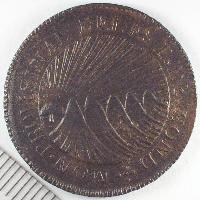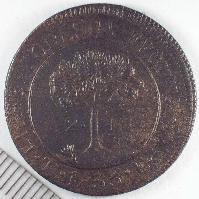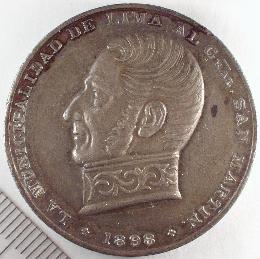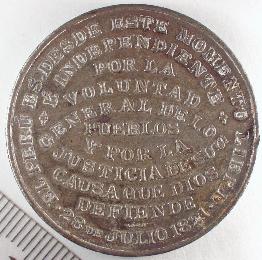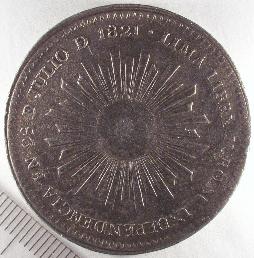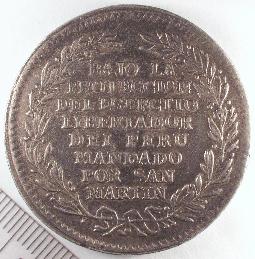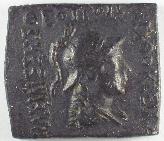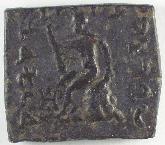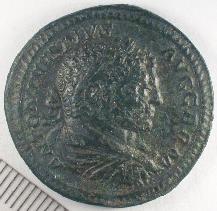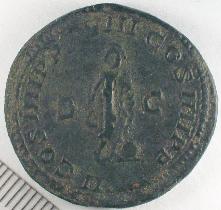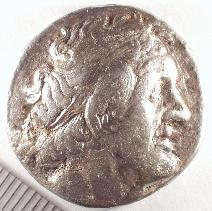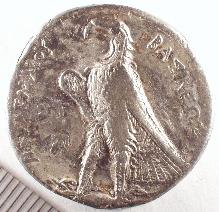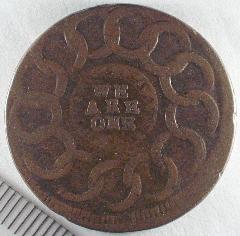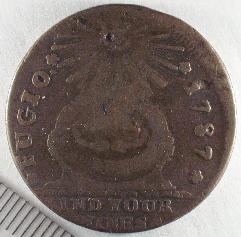Chatter
archive
also available
| Chicago Coin Club |
|---|
| Volume 50 No. 2 |
February 2004 |
|---|
--Urgent and Important--
New Meeting Space
For the last few years, the club has been fortunate in being able to meet
in a beautiful room with excellent visual equipment, all at no charge.
Unfortunately, the bank will need all of its meeting rooms for some in-house training programs,
for at least the first half of 2004.
The club is looking for another downtown meeting place,
but our space, budget, and late meeting time limit our options.
Harlan Berk has offered us his upstairs space for our February 11 meeting;
use the building entrance at 77 West Washington,
and go to Suite 1320.
Speaker's Wor[l]d
Crusader Gold Coins, 1096 to 1450 AD
Presented by Robert D. Leonard, Jr. to our January 14, 2004 meeting.
The First Crusade was called by Pope Urban II in 1095,
at the request of the Byzantine Emperor for the purpose of protecting Christian pilgrims.
It started the following year with four states soon formed in the Levant:
Kingdom of Jerusalem,
Principality of Antioch,
County of Tripoli (in modern Lebanon, not to be confused with the Tripoli in modern Libya),
and the County of Edessa.
The size of these states fluctuated over time,
with a new crusade typically called following some major loss.
Some of these states issued their own coins.
Edessa had been the first state created, and it was the first to be lost.
Its loss resulted in the Second Crusade, but it never was recovered.
The total victory by Saladin in 1187 resulted in the Third Crusade
which recovered much territory.
However, not everything was made as before;
the restored Kingdom of Jerusalem did not include the city of Jerusalem,
and the island of Cyprus became a Crusader state at this time.
Richard the Lionhearted of Britain, Phillip II of France,
and Frederick Barbarossa set out on this crusade,
but Barbarossa drowned enroute.
The Fourth Crusade started in 1204 but never arrived in the Holy Land.
It had started in Venice, but the forces captured Constantinople from the Byzantines
who were in the middle of a civil war.
The Byzantine emperor could not deliver on promises made to the crusaders,
so the crusaders established the "Latin Empire" in the areas they soon controlled.
Meanwhile, eastern Anatolia remained under Byzantine rule as the kingdom of Nicea,
which recovered Constantinople in 1271.
The Crusader states hugged the eastern Mediterranean shoreline;
Frederick II negotiated the return of Jerusalem,
but the Crusader territory did not extend much farther.
After the eastern coast was lost for the last time in 1291,
Crusader states remained on Cyprus, the Greek mainland,
and some islands off the cost of Anatolia.
But those enclaves would fall over time.
The coinage of the Crusader era had simple denominations: only one silver coin (called a penny or denier)
was used in western Middle Age Europe, while two gold coins (dinar and quarter dinar)
were used in the Middle East.
Evidence, in the form of silver coins from all over western Europe,
indicates that the crusaders came from a wide geographic area.
They used the coins they brought with them,
but they were not adverse to using the gold coins of the Middle East;
the first locally produced Crusader coins closely matched the dinar in appearance,
but the design and purity changed over time.
Bob demonstrated this with four coins used in the Kingdom of Jerusalem:
-
A genuine dinar dated 508 AH (1114/5 AD).
It weighs 4.21 grams and is 99% gold,
which agrees with the "highly refined" part of the inscription.
-
A Crusader imitation of the above piece.
It is about the same size, weighs under 4 grams,
and is about 80% gold.
(The first imitations had been above 90% fine,
but 1148-1165 saw the introduction of 80% gold.)
-
A ragged looking piece with thicker legends;
the reddish hue is from the diminished gold content of about 67% or 16 karat.
These were struck from 1187 to 1250 when Bishop Odo,
on crusade with Louis IX,
discovered that these crusader-struck coins still carried the Muslim declaration of faith!
He forbade this and wrote a letter to Pope Innocent IV, whose reply approved of the change.
-
Starting a 1251, a cross is the central device;
and the legend, while still in Arabic, now says, "Father Son and Holy Spirit,"
and “Struck at Acre in the year one thousand two hundred, seven and fifty” (1257).
Bob then used four coins from the County of Tripoli
to demonstrate a parallel evolution:
-
A genuine Muslim coin issued in 1049 by a different ruler (slightly clipped).
-
A crusader imitation of this piece, except this has one fewer line of inscription.
It is of good color and size, and is of the type issued from circa 1140 to 1160.
-
An 1187-1250 piece having the same rough fabric as that of the Kingdom of Jerusalem piece from Acre.
The color is wrong, and it is 64% gold.
-
A crude piece with a small cross, probably issued circa 1251-1260.
Muslim influence also is found in the issuance of cut gold goins.
Because the one denomination of Muslim gold coins had guaranteed fineness,
they passed by weight;
change was made by cutting pieces.
The crusaders made special coins for cutting up;
they had designs unique to this coinage,
and Latin inscriptions to simplify identification.
The early pieces were pie-shaped,
but later coins were rectangular (maybe a rounded edge)
and were cut into rectangular shapes.
It appears a number of designs were used, but they are hard to reconstruct;
a hoard in the ANS allowed some reconstruction work.
These coins were not issued whole; they were issued already cut into pieces!
Bob knows of no parallel coinage.
The talk concluded with a demonstration of Crusader coins imitating Byzantine coins:
-
A gold coin from Nicea of John III Vatatzès (1222-1254)
shows him and the Virgin on one side and Christ on the other side.
-
An imitation from the Latin Empire shows slight differences in the letter shapes,
and has a straight line nimbus instead of a beaded nimbus around the head of Christ.
Originals and imitations had the same gold content (about 2/3 fineness)
and circulated side by side from 1236 to the 1240s.
The originals and imitations have been extensively studied,
especially the bead count on the king's figure.
Although the beads were long thought to be the distinguishing feature
between original and imitation,
the nimbus was recently identified as the key distinguishing feature.
Crusader coins were primarily a working coinage, and to be successful in that purpose,
they had to be readily identifiable and accepted by the locals.
Even when items from the Crusader's religion finally were incorporated in the coin designs,
the overall design still retained much of the local flavor as on the earlier coinage.
Show and Tell
Each image has a scale in the lower-left corner,
with the tics spaced 1 mm apart.
Because the brightness and contrast were manipulated on a computer,
the coloring of a coin's image differs from the coin's actual coloring.
-
Before showing his usual piece of primitive money,
Carl Wolf
showed another recent high-value commercial token;
a token worth "$100 + 2%" in the form of a black stone disk.
The imprint was laser engraved then gold filled, and was produced by an award company that specializes in cultured stone awards.
Carl's latest framed display is an Iron Currency Bar used in the Benue Valley of Nigeria from the 16th to 20th centuries.
Produced from native smelted iron, each locale and smelter produced a specific and unique shape and each had its own name.
Most had a rough appearance, were about one foot in length but had no distinguishing marks.
During the early period, bride-price negotiations required iron currency bars and the price often exceeded 100.
In the 16th century, male slaves held a value of 13 bars and 10 bars purchased a female slave.
Iron provided an excellent way for Nigerians to store their wealth
because they could always smelt and beat it into agricultural implements, weapons and body ornaments.
The difficulty in transporting the bars caused their value to increase the farther they traveled from the smelter.
-
John Connolly
showed a selection of seven Columbian half dollars;
one showed doubling on the letters and date on the reverse.
Most were uncirculated or showed just a trace of wear,
which led to some comments on eye appeal and purchase price.
-
Sharon Blocker
reported her first numismatic find in an antique store,
a 1990 Central States Convention Badge.
Then she showed a Canadian 2003 five-coin hologram set.
The holograms are etched on the reverse,
and the obverse has a "line" matte finish.
All coins are pure silver, with the smallest assigned a face value of one dollar.
-
Bob Weinstein
showed some recently acquired ancient coins:
-
A counterfeit (silver plate over a copper core)
of Macedon under Roman occupation.
The reverse has some wrong letters in the legend.
-
A Persian siglos with two merchant punchmarks on the reverse.
The punches started simple (just a point)
then became more complicated over time;
one punch here is a foot.
-
A counterfeit of the above type,
with a break in the plating.
-
A number of Indo-Scythian coins bought on eBay.
These are good varieties,
and we had a slight digression into Bob's positive experiences on eBay.
But nothing beats being a knowledgeable buyer.
-
A king on horseback on the obverse and a god on the reverse,
it is silver plated on copper,
and the gibberish Greek legend is unintelligible.
A rosette (the family symbol) in front of the horse's head indicates the issuer.
-
Another coin struck by the same ruler,
having a nice full, large flan.
The reverse inscription, now in the local language,
is complete and gives the king's full name.
-
A coin from the successor to the above king.
-
Don Dool
showed some recent acquisitions:
-
For his South American scripophily collection,
a Credito Popular Territorial stock certificate for diez (10) pesos
dated 22 de Junio 1884, issued in La Plata, Province of Buenos Aires, Argentina.
Nineteenth century certificates from South American countries
are not especially common; those from smaller cities are even harder to find.
La Plata, noted for its huge cathedral, at one time changed its name to "Eva Peron".
-
Honduras, 1833, 2 reales, counterfeit. Official issue is .333 silver,
this one has only traces of silver and has the word PROVISIONAL spelled PROVISINAL.
-
Medal issued in 1898 by the city of Lima, Peru honoring San Martin.
Two references for this medal list it in copper, but this one is silver.
If it were the other way around one might suspect a counterfeit.
Earlier in the day, Don visited with
Tom DeLorey who performed a specific gravity test on this coin;
his verdict: silver.
-
Medal issued July 28, 1821 proclaiming the independence of Peru under
the protection of San Martin. This medal weighs 20.9 gm. and is 36 mm.
in diameter. Three others that Don knows of are:
38.7 mm and 23 gram, 37.8 mm and 25.8 gram, and 32.3 mm and 22.93 grams.
X-ray analysis determined that the reason for this medal being lighter
is its being an alloy of silver and tin.
This was an eBay acquisition that went bad: misrepresentation plus shipping problems.
-
In early December,
Cliff Mischler
went to California and visited five clubs.
A club in Stockton prints its newsletter on recycled U.S. currency,
and Cliff was given a ream of that paper.
A goody bag from another club contained a ruler made from recycled plastic and paper money.
He closed with a Chicago item,
a pencil from the Chicago Title company made with just regular recycled paper.
-
Mark Wieclaw
continued some past exhibiting themes:
-
The lead seals from U.S. silver eagle boxes.
The "2003" and "W" from last year usually are off center,
but the "2004" and "WP" from this year have a nicer look.
He then wondered if there are other crazy collectors out there.
-
A rectangular hemi-obol, circa 130BC,
from the Indo-Scythians of Bactria;
the bust of the king on obverse and Hercules on the reverse.
-
A Caracalla As (9.51 grams) from Rome, 215AD.
Double struck on the obverse (two faces slightly misaligned),
but the reverse is double struck, off by 180 degrees;
on the reverse, notice the repeated legends, the expected "S" appearing as a backwards "C,"
and the extra head of Aesculapius appearing near the feet.
We could not tell if the second strike used the same or a different reverse die.
-
Chuck Jacobs
showed military medals.
-
A Japanese medal from the Russian-Japanese War,
bought from a coin company ad.
It came with the original polonia wood box,
and a catalogue listing more items.
He bought the following World War II medals:
-
A Japanese 1939 "China Incident" medal,
which was for its WWII actions in China,
in its original cardboard box.
-
A U.S. Asiatic Pacific Campaign medal.
-
A U.S. WWII victory medal, with the rainbow colors on the two rainbows
taken from the WWI medal.
-
The WWII Soviet Union victory over Japan medal.
After he showed these to his father,
his father gave him his
Liberation of the Philipines bar,
and the occupation of Japan medal
which shows two fishing boats in front of Mount Fuji on one side,
and the Ludendorf Bridge on the other (the medal was used for Europe also).
-
Bill Burd
brought an item from the recent Kolbe literature auction,
I.G. Mazzini's Imperial Russian Coins from 1967.
Only 500 copies of this five volume work were produced,
and Dennis Kroh gives it five stars in Ancient Coin Reference reviews.
Its 537 plates show 1,261 gold coins and 1,641 large bronzes.
-
Bob Feiler
showed two coins he had submitted to the Numismatic Conservation Service:
-
A few months ago, Bob showed this Ptolemy I tetradrachm;
now it looks better.
-
A 1787 Fugio Cent with club rays,
in which someone had tried drilling a hole.
The charge for cleaning each coin was $15,
and Bob is satisfied with the results.
He showed their 10-page pamphlet,
which never explicitly mentions cleaning.
Club Business
Board Meeting
The club's board met on January 21,
and two items will be discussed at a future regular club meeting:
-
The board recommends that beginning in 2005 club dues be increased from $10.00 to $15.00
and that Life Membership dues be increased from $300.00 to $375.00.
-
The board recommends that at future banquets or off site meetings,
Speakers (invited or club members) and a guest, should receive a
free dinner paid for by the club treasury not by increasing the cost of the dinner to attendees.
Committee Report
85th Anniversary Meeting
The club's 85th Anniversary Banquet will be held at the Holiday Inn, North River Road, Rosemont, IL
on Saturday May 1st; in conjunction with the Chicago International Coin Fair.
Some aspects have been finalized while others still need some attention.
Price is set at a break even of $39 per person,
and the Holiday Inn will provide vouchers to park for $6
instead of $10.
We hope for 45 to 50 people.
The appetizers will be donated by Chicago Coin Company,
and the plan is for an open Cash bar
300 invitations will be printed.
A separate slip can be inserted into each invitation with the name of the
speaker and subject when known.
We will supply a sufficient quantity of invitations to Kevin Foley and ask
him to mail them to the CICF dealers.
Carl Wolf will locate a speaker.
The give away to attendees will be an encased postage stamp, with 85 to be produced.
Sharon Blocker will do the write up.
Bob Feiler will make the brass encasements and supply the Mylar for windows.
Steve Zitowski will supply the special stamp for the encasement with the
Athenian Owl design similar to that used for our 1000th meeting medals.
Several people volunteered to help put the postage encasements together,
and Bill Burd offered the use of his shop for the assembly of the encasements.
Mark Wieclaw will take care of the printing cost.
The committee agreed to use a Mylar flip and have a small folded
booklet type of insert with a brief explanation of encased postage and an
abbreviated story of the Chicago Coin Club.
Our 1022nd Meeting
| Date: | February 11, 2004 First session |
| Time: | 7:00 PM |
| Location: | Downtown Chicago
In a meeting room provided by Harlan Berk; at 77 W. Washington St., Suite 1320. |
| Featured speaker: | Mark Wieclaw
- The Silver Drachms of Parthia |
|
The ancient Kingdom of Parthia covered lands of what is today western Turkey,
much of Syria and all of Iraq and Iran.
The Parthian Kings issued coinage from the 2nd century B.C.
through the 3rd century A.D.
Mark Wieclaw has collected this series of ancient coins since 1981
and will cover the story of Parthian imperial portraits that imitated Roman coinage
and how the reverse types are consistent with the Greek Seleucids who they displaced.
|
| |
| Date: | February 28, 2004 Second session |
| Time: | 1:00 PM |
| Location: | at the Chicago Paper Money Expo (CPMX),
which is held at the Holiday Inn O'Hare, 5440 North River Road, Rosemont, IL.
No admission charge for our meeting. |
| Featured speaker: | Allen Mincho
- Illinois National Bank Notes |
|
|
Important Dates
|
Our February meeting will consist of two sessions:
we will end the first session with a recess (instead of an adjournment),
and we will reconvene for the second session at the CPMX. |
| February |
11 |
CCC Meeting - Featured Speaker - Mark Wieclaw on The Silver Drachms of Parthia |
| February |
27-29 |
10th Annual Chicago Paper Money Expo (CPMX)
at the Holiday Inn O'Hare, 5440 North River Road, Rosemont.
Admission is $5. |
| February |
28 |
CCC Meeting - 1pm at the Chicago Paper Money Exposition,
which is held at the Holiday Inn O'Hare, 5440 N. River Road, Rosemont, IL.
No admission charge for our meeting.
Featured Speaker - Allen Mincho on
Illinois National Bank Notes |
| |
| March |
10 |
CCC Meeting - Featured Speaker - John Connelly on $1.00 U.S. Coins from Eisenhower to Sacagawea |
| |
| April |
14 |
CCC Meeting - Featured Speaker - Andy Plioplys on The Early Coinage of Lithuania, 1100 - 1400 AD |
| April 30-May 2 |
29th Annual Chicago International Coin Fair (CICF)
at the Holiday Inn O'Hare, 5440 North River Road, Rosemont.
Admission is $5. |
| |
| May |
1 |
CCC Meeting - 1pm at the Chicago International Coin Fair (CICF),
which is held at the Holiday Inn O'Hare, 5440 North River Road, Rosemont, IL.
No admission charge for our meeting.
Featured Speaker - Richard Giedroyc on
Numismatic Issues from the House of Dracula and House of Frankenstein |
Birthday and Year Joined
| March |
7 |
Bruno Rzepka |
1968 |
| March |
14 |
Donald R. Srbeny |
1987 |
| March |
16 |
Michael Brodsky |
1991 |
| March |
16 |
Joseph T. Tomasko |
1984 |
| March |
19 |
Charles Ricard |
1963 |
| March |
20 |
Sidney Bick |
1953 |
| March |
25 |
David B. Silberman |
1971 |
| March |
29 |
Nancy Wilson |
1984 |
| March |
31 |
Andrew E. Michyeta III |
1984 |
Chatter Matter
All correspondence pertaining to Club matters
should be addressed to the Secretary and mailed to:
CHICAGO COIN CLUB
P.O. Box 2301
CHICAGO, IL 60690
Visit Our Web Site
http://www.ChicagoCoinClub.org/
Contacting Your Editor
| Paul R. Hybert
|
| prhybert@worldnet.att.net |
Club Officers
| Mark Wieclaw | - President |
| Robert Feiler | - First Vice President |
| Jeff Rosinia | - Second Vice President |
| |
| Directors: | Lyle Daly
Mike Metras
Steve Zitowsky
Carl Wolf |
| |
| Other positions held are: |
| Robert Weinstein | - Secretary |
| Steve Zitowsky | - Treasurer |
| Paul Hybert | - Chatter Editor |
| Phil Carrigan | - Archivist |
